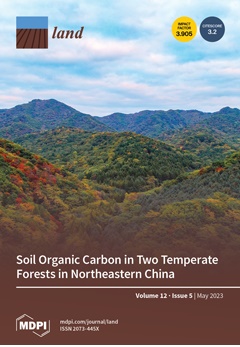Ver ítem
- xmlui.general.dspace_homeCentros Regionales y EEAsCentro Regional Patagonia SurEEA EsquelArtículos científicosxmlui.ArtifactBrowser.ItemViewer.trail
- Inicio
- Centros Regionales y EEAs
- Centro Regional Patagonia Sur
- EEA Esquel
- Artículos científicos
- Ver ítem
Nitrogenous and Phosphorus Soil Contents in Tierra del Fuego Forests: Relationships with Soil Organic Carbon, Climate, Vegetation and Landscape Metrics
Resumen
Soil nitrogen (SN) and soil phosphorus (SP) contents support several ecosystem services and define the forest type distribution at local scale in Southern Patagonia. The quantification of nutrients during forest surveys requires soil samplings and estimations that are costly and difficult to measure. For this, predictive models of soil nutrients are needed. The objective of this study was to quantify SN and SP contents (30 cm depth) using different
[ver mas...]
Soil nitrogen (SN) and soil phosphorus (SP) contents support several ecosystem services and define the forest type distribution at local scale in Southern Patagonia. The quantification of nutrients during forest surveys requires soil samplings and estimations that are costly and difficult to measure. For this, predictive models of soil nutrients are needed. The objective of this study was to quantify SN and SP contents (30 cm depth) using different modelling approaches based on climatic, topographic and vegetation variables. We used data from 728 stands of different forest types for linear regression models to map SN and SP. The fitted models captured the variability of forest types well (R2-adj. 92–98% for SN and 70–87% for SP). The means were 9.3 ton ha−1 for SN and 124.3 kg ha−1 for SP. Overall, SN values were higher in the deciduous forests than those in the mixed evergreen, while SP was the highest in the Nothofagus pumilio forests. SN and SP are relevant metrics for many applications, connecting major issues, such as forest management and conservation. With these models, the quantification of SN and SP stocks across forests of different protection status (National Law 26,331/07) and national/provincial reserve networks is possible, contributing to the determination of nutrient contents at landscape level.
[Cerrar]

Autor
Martínez Pastur, Guillermo José;
Aravena Acuña, Marie-Claire;
Chaves, Jimena Elizabeth;
Cellini, Juan Manuel;
Silveira, Eduarda M.O.;
Rodríguez‑Souilla, Julián;
Von Müller, Axel;
La Manna, Ludmila;
Lencinas, María Vanessa;
Peri, Pablo Luis;
Fuente
Land 12 : 983. (May 2023)
Fecha
2023-04-28
Editorial
MDPI
ISSN
2073-445X
Formato
pdf
Tipo de documento
artículo
Palabras Claves
Derechos de acceso
Abierto
 Excepto donde se diga explicitamente, este item se publica bajo la siguiente descripción: Creative Commons Attribution-NonCommercial-ShareAlike 2.5 Unported (CC BY-NC-SA 2.5)
Excepto donde se diga explicitamente, este item se publica bajo la siguiente descripción: Creative Commons Attribution-NonCommercial-ShareAlike 2.5 Unported (CC BY-NC-SA 2.5)
Metadatos
Mostrar el registro completo del ítem
Excepto si se señala otra cosa, la licencia del ítem se describe como info:eu-repo/semantics/openAccess
Ítems relacionados
Mostrando ítems relacionados por Título, autor o materia.
-
La investigación en bosques nativos acompañando al desarrollo sustentable
Peri, Pablo Luis (Colegio de Graduados en Ciencias Forestales de Santiago de Estero, 2020)Los bosques nativos en Argentina, con su gran variedad de ecosistemas que incluyen desde selvas subtropicales hasta bosques subantárticos, brindan a la sociedad diferentes servicios ecosistémicos (alimentos, agua, madera, ... -
Propuesta de protocolos y lineamientos para evaluar planes de manejo de uso sustentable de los bosques
Rusch, Veronica Elena (Ediciones INTA, 2017)Par el empleo del protocolo, se propone pensar la evaluación como si fuera en una tabla donde se incluya cada una de las preguntas a considerar en la primera columna. La evaluación me permitirá responder si el aspecto de ... -
Uso sostenible del bosque. Aportes desde la Silvicultura Argentina
Peri, Pablo Luis; Martinez Pastur, Guillermo José; Schlichter, Tomas Miguel (Ministro de Ambiente y Desarrollo Sostenible de la Nación, 2021-09-22)En esta obra se presentan los análisis del uso forestal histórico hasta la actualidad, la situación resultante del estado del bosque nativo y las propuestas silviculturales para que, en función de todo ello, proponer ...


